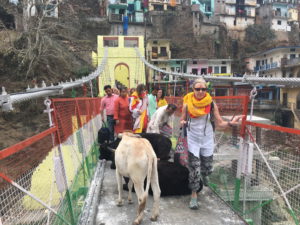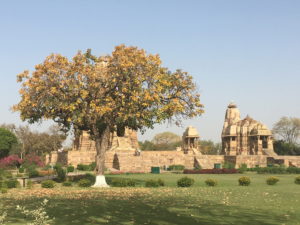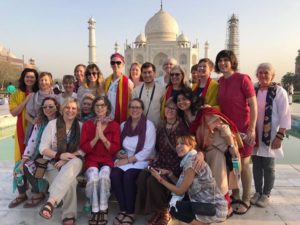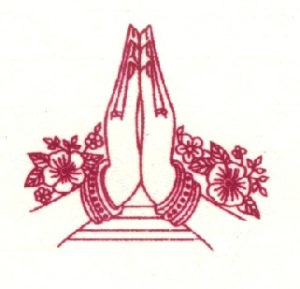Why do so many Yogis make a pilgrimage to India? A pilgrimage is a different kind of journey. It has a deeper, personal purpose. A pilgrimage is a journey of spiritual significance, in search of spiritual growth. My recent trip to India was more of a pilgrimage than a vacation. I went to India in search of wisdom – about Yoga, about myself, believing that Yoga is the path to that wisdom.
It is incredibly challenging to describe India in a few words. When I think of India, 3 phrase come to mind – 1) sensory overload, 2) coexistence, and 3) spirituality.
While in India, every single sense organ was awakened and stimulated – the eyes beheld the vibrant colors, the beautiful people, the spectacle of the overcrowded streets; the ears rang with the constant car horns, the dogs barking, the chanting; the nose smelled the spices, the incense, the flowers; the tongue enjoyed the spicy food, the delicious naan bread; and the skin felt the hot, hot Indian sun. Woven into all the intensity that is India, is an undercurrent of stillness, of peace.
A friend used the term “Peaceful Insanity”.
This is what I mean by coexistence. The streets are … CRAZY, at least to us Westerners, but apparently, completely normal for India. The streets are filled with cars, rickshaws, buses, people, dogs and cows with no apparent order. At first glance, it appears and sounds chaotic, with all drivers having one finger firmly fixed on the horn. Apparently, however, there is a certain pecking order on the street. The pedestrian is at the bottom, giving way to the bicycle rickshaw, then the auto rickshaw, then the car, then the bus. The bus stopping only…. for the Holy Cow that rules the street. Then you veer off this busy street, make a quick turn, and enter through a gate into a beautiful garden or temple. Complete juxtapositions. The chaos and the peace co-existing.
When I speak of spirituality, I’m not talking about any particular religious worship. Spirituality is a search for meaning, for purpose and direction in life. It fulfils our need to have a foundation for living, a path or way of life in the light of a larger context. It speaks to the need to be “aligned” with something bigger than our body and mind. The religions of India (whether it be Hinduism or Buddhism) and their spirituality are greatly misunderstood in the West. Although there are many statues representing numerous deities, it is not about idol worship. What I’ve learned is that all the deities and their different forms and manifestations represent important values that guide us on our path towards spiritual growth.
From my experience, Indian people live spiritual lives where their daily actions are influenced by their belief in loving kindness and compassion to all beings. Imagine what life would be like here if everyone you came into contact with, greeted you with a heartfelt bow, hands to their heart, saying Namaste.
Namaste – we say it at the end of every yoga class. What does it really mean? Nama means bow, as means I, and te means you.
Therefore, namaste literally means “I bow to you.” Namaste is usually spoken with a slight bow and hands pressed together, palms touching and fingers pointing upwards, thumbs close to the chest. The gesture represents the belief that there is a Divine spark within each of us that we recognize as One.
My pilgrimage to India included time in Delhi (the capital), Agra (to see the Taj), Khajuraho and Rishikesh. Everywhere I went, I was impressed with the ever-present juxtapositions – from the grand palaces and temples to the poverty in the streets, from the NOISE to silence in meditation.
I had the privilege to stay at the Himalayan Institute (HI) in Khajuraho, founded by the great Swami Rama. The Institute’s 30-acre campus is the ideal setting for sadhana or spiritual retreat. Surrounded by hills and forest preserves, it is blessed with natural beauty and tranquility. Here, we studied, meditated, practiced asana, chanted and grew together as a beautiful spiritual community.
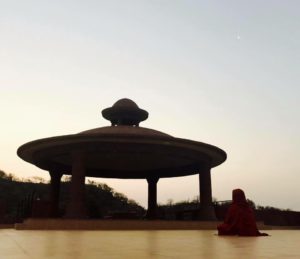 We studied a book called the Devi Mahatmyam – the Glory of the Goddess, an ancient allegory. Part myth and part philosophy, the text addresses some very important existential questions that have plagued mankind since time immemorial. Its stories can be taken as metaphors relating to our own psycho-spiritual development, as well as the challenges we face in life.
We studied a book called the Devi Mahatmyam – the Glory of the Goddess, an ancient allegory. Part myth and part philosophy, the text addresses some very important existential questions that have plagued mankind since time immemorial. Its stories can be taken as metaphors relating to our own psycho-spiritual development, as well as the challenges we face in life.
Rishikesh was the exact opposite experience. Rishikesh is a city on the Ganges river that is renowned for being a holy site and a pilgarimage location. Hindu sages have traditionally come here to meditate throughout the centuries. All of the great yoga masters have their roots here. The spiritual connections here mean that it is a place that is free of both meat and alcohol.
Rishikesh has also been given the name of “the yoga capital of the world” as students from all over the globe, including myself and the Beatles in the late 1960s, converge here to learn the ancient wisdoms of yoga. YOGA, we learned over and over again, is “simply” a way of life, a way of being and the Wisdom that we seek is found in ourselves. Siddhartha Krishna, a compelling Yoga Philosophy Teacher, that we had the great honor to learn from, told us that the most important component of yoga is Ahimsa, literally translated as nonviolence, which is really all about compassion. Yoga gives us the tools so that we can practice compassion.
In the words of Swami Shivananda who began the Divine Life Society, the goal of Yoga is to:
SERVE LOVE GIVE
PURIFY MEDITATE REALIZE
With deepest gratitude to my fellow pilgrims and teacher, Indu Arora.

